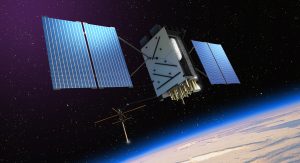
The Middle East is set to benefit from multiple global navigation satellite systems (GNSS) currently under development by China, India, Europe, Russia, and the United States.
The United States especially is a global GNSS powerhouse, and US aerospace company Lockheed Martin is developing the next generation US GNSS capability, Global Positioning System (GPS) III. The primary client for GPS III is the US Air Force and other US government clients, but US policy also requires that the GPS signal is provided for free to users around the world. Further, US allied and friendly governments around the world are able to access the GPS precision signal, also for free.
Additionally, other GNSS capabilities such as Europe’s Galileo, Russia’s GLONASS, China’s BeiDou, and India’s Navic cannot be as effective as they are if the US GPS system is not fully operational. In short, multiple GNSS capabilities offer undoubted benefits to users in the Middle East and beyond, but multiple GNSS is not possible without the US GPS capability available for free to global users.
With GPS III, when mission needs change for GPS the US Air Force will be able to respond — thanks to some engineering forethought and the innovative design of Lockheed Martin’s GPS III satellites.
Designed with evolution in mind, Lockheed Martin’s GPS III satellites for the US Air Force’s next acquisition will be able to offer on-orbit re-programmability so they can be upgraded in space to add new signals or missions, a first for the GPS constellation. The satellite’s modular design will also allow for low risk, easy insertion of new, future technology into the production line – guaranteeing GPS III remains the gold standard for positioning, navigation and timing (PNT).
Lockheed Martin will demonstrate the value of its flexible GPS III design over the next 26 months, as part of the US Air Force’s GPS III Space Vehicles 11+ Production Readiness Feasibility Assessment. On 5 May 2016, the US Air Force awarded Lockheed Martin a US$5 million contract for Phase 1 of this procurement for future GPS III satellites.
Lockheed Martin has already made advancements on the US Air Force’s future GPS III requirements. In 2013 the company completed a preliminary design review for two key future requirements: the accuracy-boosting Laser Retro-reflector Array and a hosted payload for search and rescue missions.
The current GPS III block design is already the most powerful GPS satellite ever built, which enables GPS III’s eight-times anti-jamming capability. For future GPS III satellites, the US Air Force is requiring Regional Military Protection, which will allow them to direct even more capability into specific contested and challenging environments.
“Lockheed Martin has already made significant progress in the area of Regional Military Protection and we are confident our GPS III will be able to bring enhanced capability to the warfighters wherever and whenever they need it,” said Mark Stewart, Lockheed Martin’s vice president for Navigation Systems. “With this and the addition of a long-planned, fully-digital navigation payload, our GPS III design will provide the Air Force with maximum flexibility for all their current and future missions.”
For much of Lockheed Martin’s progress and advanced risk reduction already completed, Mr. Stewart credits the US Air Force’s previous investment, the Back to Basics program and the use of an innovative satellite prototype known as the GPS III Nonflight Satellite Testbed (GNST). The company used the GNST to already prove its GPS III design was compatible with the next generation ground control system and the existing GPS constellation back in 2013.
“Innovation like the Air Force’s GNST helped us retire most risks when adding these latest capabilities,” Stewart says. “Our design for GPS III builds on our plan to drive costs down with increased efficiencies.”
Lockheed Martin’s GPS III production line is in full swing. In December 2015, the first GPS III satellite completed system-level Thermal Vacuum (TVAC) testing, validating Lockheed Martin’s design and manufacturing processes. Seven more GPS III satellites are following the first one in production flow at Lockheed Martin’s GPS Processing Facility in Denver, Colorado.
The GPS III team is led by the Global Positioning Systems Directorate at the US Air Force Space and Missile Systems Center. US Air Force Space Command’s 2nd Space Operations Squadron (2SOPS), based at Schriever Air Force Base, Colorado, manages and operates the GPS constellation for both civil and military users around the world.
Referring to the civil and commercial advantages of GPS III, Chip Eschenfelder, a Lockheed Martin executive, told SpaceWatch Middle East that, “Perhaps the biggest benefit non-military users will see is GPS III’s addition of the L1C Civil Signal – a first for any GPS satellite. This signal will make the satellite compatible with other Global Navigation Satellite Systems (GNSS) that are in development (like Europe’s Galileo system), which will improve civil/commercial mobile GPS reception in cities and other challenging environments. Essentially, your personal GPS receiver will have more satellite options it can “connect” line-of-sight with, which is important if you need three satellites to determine location and a fourth to determine altitude, especially in areas where satellites might be blocked by buildings, mountains or canyons.”
 SpaceWatch.Global An independent perspective on space
SpaceWatch.Global An independent perspective on space

